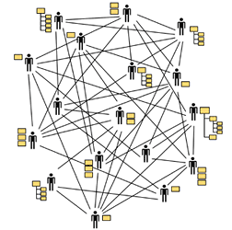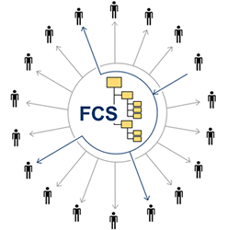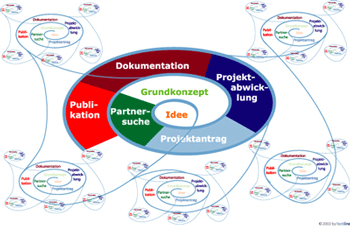|
I. Overview |
|||||
 | |||||
| Developments in the
area of information and communication technologies create a changing
working environment in which so-called knowledge work is playing a
more and more central role. A decisive characteristic of knowledge work is the usage of one's own as well as other people's knowledge resources in order to solve problems. New knowledge is developed by identifying, using and combining existing knowledge. At this point, the immense importance of exchanging knowledge with others should be highlighted. Knowledge work always implies collaboration (  distributed knowledge work). distributed knowledge work).These elements have always been part of knowledge-based work. However, they have gained significant importance due to the development of the Internet and the subsequent creation of new communication and information infrastructures. In the meantime, web-based collaboration via Internet has become indispensable. More and more often, central Internet communication platforms are used rather than communicating via e-mail and sending files back and forth. The stated reasons are increased efficiency due to central structuring and archiving of information as well as the usage of a common communication infrastructure which can be accessed by all participants. 

fig. 1: Increase of efficiency via usage of an internet platform (central structuring and archiving) as opposed to e-mail A further but rarely used strength of internet platforms is the possibility to involve co-workers in the knowledge development process at an early stage. By doing so, knowledge workers do not only use the Internet to transport end results. Instead the expertise of others is included in the thinking process as early as possible. Due to the fact that distributed knowledge workers are usually members of several project groups, expertise of other knowledge areas can be included. The result of such distributed, web-based knowledge work is oftentimes dynamicly linked hypertext of a collective of authors which in turn is linked with hypertexts of other collectives. The contextualization and integration of texts in these kinds of living knowledge repositories creates added value which cannot be shown in a printable form. 
fig. 2: distributed, web-based knowledge work by hypertextually linking to different knowledge areas However, a fundamental obstacle needs to be overcome: the uncertainty of whether and how long integrated text or rather text modules will be available in the Internet. At present, there is no accepted principle authors can rely on if they want to integrate web-generated text in their hypertext. A typical reference to web-generated text reads basically as follows: The page looked like that when I visited it that day for the last time. At the same time, authors do not have a possibility to signalize other authors how to deal with their texts. As a result, the potential of Internet technologies is not used: texts are printed out, documents are stored on hard disks etc. This problem is the origin of the following contemplation.
First, a short
In
In
|
|||||

